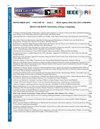A Novel Methodology for Determining Steady-State Security Regions Using Artificial Neural Networks in Near Real-Time Applications
IF 1.3
4区 工程技术
Q3 COMPUTER SCIENCE, INFORMATION SYSTEMS
引用次数: 0
Abstract
The increasing penetration of variable renewable energy sources, such as photovoltaic and wind power, poses significant challenges to the real-time security assessment of power systems. In this context, the Steady-State Security Regions framework has emerged as a robust tool for voltage security assessment, providing valuable insights into the steady-state operating limits of electrical networks. However, the computational burden associated with determining these regions during system operation remains a major obstacle for current methodologies. This paper presents a novel approach for efficiently identifying these regions using artificial neural networks, enabling the fast and accurate delineation of security boundaries suitable for real-time and near-real-time applications. The methodology was validated on the IEEE 9-Bus and New England test systems, achieving accuracy comparable to conventional techniques while reducing computational time by up to 96%. The results underscore the potential of the proposed method as a scalable and effective tool to support operational decision-making in power systems with high shares of renewable generation.在近实时应用中利用人工神经网络确定稳态安全区域的新方法
随着光伏、风电等可变可再生能源的日益普及,对电力系统的实时安全评估提出了重大挑战。在这种情况下,稳态安全区域框架已成为电压安全评估的强大工具,为电网的稳态运行限制提供了有价值的见解。然而,在系统运行期间与确定这些区域相关的计算负担仍然是当前方法的主要障碍。本文提出了一种利用人工神经网络有效识别这些区域的新方法,能够快速准确地描绘适合实时和近实时应用的安全边界。该方法在IEEE 9-Bus和新英格兰测试系统上进行了验证,达到了与传统技术相当的精度,同时将计算时间减少了96%。结果强调了所提出的方法作为可扩展和有效的工具来支持具有高可再生能源发电份额的电力系统的运营决策的潜力。
本文章由计算机程序翻译,如有差异,请以英文原文为准。
求助全文
约1分钟内获得全文
求助全文
来源期刊

IEEE Latin America Transactions
COMPUTER SCIENCE, INFORMATION SYSTEMS-ENGINEERING, ELECTRICAL & ELECTRONIC
CiteScore
3.50
自引率
7.70%
发文量
192
审稿时长
3-8 weeks
期刊介绍:
IEEE Latin America Transactions (IEEE LATAM) is an interdisciplinary journal focused on the dissemination of original and quality research papers / review articles in Spanish and Portuguese of emerging topics in three main areas: Computing, Electric Energy and Electronics. Some of the sub-areas of the journal are, but not limited to: Automatic control, communications, instrumentation, artificial intelligence, power and industrial electronics, fault diagnosis and detection, transportation electrification, internet of things, electrical machines, circuits and systems, biomedicine and biomedical / haptic applications, secure communications, robotics, sensors and actuators, computer networks, smart grids, among others.
 求助内容:
求助内容: 应助结果提醒方式:
应助结果提醒方式:


